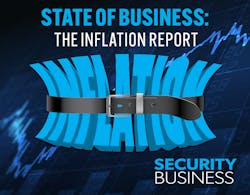This article originally appeared as the cover story in the March 2023 issue of Security Business magazine. When sharing, don’t forget to mention Security Business magazine on LinkedIn and @SecBusinessMag on Twitter.
Many consumer and business products are reaching all-time high costs after two years of worldwide inflation. In the U.S., month-to-month inflation peaked at 9.1% in June 2022. Still, during January 2023, the consumer price index rose another 6.4%. Aggressive steps by the U.S. Federal Reserve, including higher interest rates, aim to slow the economy and curb spiraling prices. A recession has followed all but one time the Fed has done so since 1961.
Virtually all large and small businesses are feeling the economic squeeze. Security integrators are no exception. To gain a greater perspective on how inflation impacts the industry, Security Business recently spoke with its exclusive three-member integrator panel, including Shaun Castillo, President of Preferred Technologies, John Nemerofsky, COO of SAGE Integration, and Michael Ruddo, chief strategy officer for IST, an Unlimited Technology Company.
How Does Inflation Impact Integrators?
It is costing integrators more to fund virtually every aspect of their businesses – including employee wages, technology, insurance, janitorial services, warehousing, safety equipment, uniforms, trucks and more. Unless the rising costs are passed to clients, these increases impact an integrator’s profit margins.
“We have to make up the difference through higher prices or live with lower profit margins,” Castillo says. “The latter is not a sustainable business model.”
The three integrators say inflation has led to regular and often sizable price increases from vendors. Throughout 2022, Ruddo says his vendors raised prices “monthly, weekly and sometimes daily. Fortunately, it is starting to cool down a bit.”
In its battle against inflation, Nemerofsky says SAGE looks to reduce or eliminate expenditures where necessary. Measuring employee utilization andMulti-year client agreements signed a year or more ago may negatively impact margins. “We can charge more as prices increase for projects,” Nemerofsky says. “But we are a bit hampered on multi-year agreements. We can’t always change those – we just make less margin.”
IST counts large federal government agencies among its clients. Many involve pre-negotiated contracts with pricing set in place, typically for years in advance; however, Ruddo says certain government contracts allow for adjustments based on interest rates set by the Federal Reserve. “Our federal clients have a tolerance for some price increases,” Ruddo says. “They understand where it is coming from; whereas on the commercial side, there is less tolerance depending on the market involved.”
Small vs. Large Integrators
Castillo sees inflation often having greater impacts on larger integrators. Much of that relates to the greater number of long-term client contracts they carry compared to their smaller industry colleagues. Ruddo counters that he sees smaller integrators likely suffering more from inflationary pressures.
“Larger integrators typically can absorb more margin erosion,” Ruddo says. “Smaller businesses will sometimes absorb more cost increases because the work keeps their doors open. They’re forced into it.”
Smaller integrators working in niche markets quickly pass along price increases as they face less competition. “I do think it comes back to that competitive landscape,” Ruddo adds. “If you are in a highly competitive landscape, inflation will impact both large and small integrators.”
Employee Compensation and New Hires
The effects of inflation on an integrator’s employees weigh heavily on an employer, Nemerofsky says. SAGE employees pay more for rent, bread, milk, eggs, gasoline and other expenses. “As an employer, we have our associates pressuring us for more money,” he explains. “The Federal Reserve says the recent cost of living has increased by 10% or more, but we can’t give 10% raises. When things normalize in a year or two, no employee will want to give back a large portion of those increases. We are trying to offset current conditions with 3% pay increases.”
Nemerofsky cites an example: SAGE recently added a large New York City account requiring five embedded personnel. Three employees, each with Lenel and Genetec certifications, the ability to drive a bucket truck and already living in the city, were hired for nearly 20% higher per hour. Two lesser positions remain unfilled three months later as candidates ask for 20% more due to inflation. “You can’t pay more for someone with less experience and skills,” Nemerofsky says.Ruddo agrees that finding quality technicians at a reasonable salary is becoming more complex. Some of that difficulty, he says, results from a “COVID hangover” that reduced the number of qualified people seeking work. And many candidates in the market have new priorities.
“People applying for jobs are hyper-focused on the salary vs. what an integrator may offer in the way of culture or work environment,” Ruddo says.
Nemerofsky says that as wages continue to soar, it becomes more difficult to recruit experienced staff from competitors. Workforce development may offer a solution by building awareness of industry opportunities. SAGE is working closely with a new entity, the Foundation for Advancing Security Talent (FAST), formed by the Security Industry Association (SIA) and the Electronic Security Association (ESA). FAST administrators hope to increase awareness of career advancement opportunities among qualified electronic tech-based employees.
Castillo recommends frequently reviewing the value each employee brings to the company. He says it is not easy, but is unfortunately necessary, to let go of those who don’t meet expectations. “It is amazing how limiting those people are to an organization,” Castillo admits. “We have seen an increase in teamwork, collaboration and communication with a few people gone, and we have seen an uptick in customer service and satisfaction, with efficiencies across the board.”
Which Costs Can Be Passed to Clients?
Castillo says he has spoken with some long-term contract clients to gain a sense of their willingness to accept price increases. “We ask them: ‘If we get to a point where we don’t make enough margin to sustain operations, are you willing to talk about changes?’ This is the reality of the situation.”
Solutions begin at the contract negotiation phase. It may involve asking clients to create a contingency fund for use when integrators can prove increased costs due to inflation. Another idea is limiting price guarantees for a specified amount of time, giving integrators the right to make increases if a contract isn’t signed promptly. “It is about being smart and looking for ways to protect both parties,” Castillo says.
Relationships Matter
Inflation makes a good case for building strong vendor relationships.
Castillo’s case in point involves a call he received from a cable provider warning of coming price increases. He and the vendor went through all current or pending Preferred Technologies contracts looking for ways to limit the pain.
“Having these types of conversations gives us the ability to react as effectively as possible to higher costs,” he says.
How Integrators can Combat Inflation
Planning and seeking efficiencies are key in fighting inflation, Nemerofsky says. “We ask ourselves what we can do in-house, such as fabrication and staging, and prepping projects to get them done in fewer hours when we get to the site.”
Anticipating rising prices, some integrators purchase products early in the project process. Castillo says he looks to buy those products he knows he will need to complete an already contracted project. Clients are invoiced immediately for quick payment. “We can’t play bank – in effect, financing projects for our customers,” he says.
Nemerofsky says savvy invoicing policies are an essential step in battling inflation. For example, SAGE gives its clients 60-day terms while, whereNemerofsky adds that SAGE now bills the same day for client service calls. “When economic times were in their heyday, we would bill at the end of the week; sometimes every other week. Knowing I have a payroll to meet, we now bill immediately after service is provided. Integrators must be sharper and quicker with their invoicing.”
Ruddo said IST is implementing enterprise resource planning software to help manage day-to-day activities and increase organizational efficiencies. “We’re looking at improving our internal processes to save money and support our operating margins.”
He says that while IST will always do project installation work, there’s a movement towards more service-based model jobs. “The delivery of services typically produces higher margins while spreading costs out over time – that’s more palatable to clients. It is positive for us to move into hosted or other off-prem solutions.”
As the Federal Reserve continues to raise interest rates to slow inflation, there is a risk that a slower economy may lead to a recession. Castillo says all indicators show a recession is looming, making this is an excellent time to conduct a full business review.
“Ask yourself if you have the right mix of clients,” he says. “Do you have enough available cash to survive a recession and thrive? Do you have the right staff to deliver on the work you win? Ideally, it would help if you were also doing these things during the good economic times.”
Ruddo, who has survived a few recessions, adds that IST has evaluated the markets it serves to target those most resilient to economic upheavals. “Government agencies are good clients as they are better protected against inflation and recession,” he says.
Effect on the M&A Market
Although it may seem counterintuitive with interest rates soaring, the merger and acquisition market is going strong, say the three integrators.
Nemerofsky says that in some cases, smaller integrators want to exit the business following the trifecta of a pandemic, supply change challenges and now inflation. During one recent week, he received calls from brokers offering three acquisition deals.
“Many companies are looking to grow their portfolio. If you are private equity-backed, you have pressure to grow. Even if you are not buying or selling, if ever there was pressure to grow, it is now. If you are not growing, how can you fund wage increases and the additional costs you have for gas and insurance – unless you are willing to make less money.”
The larger integration companies see mergers and acquisitions as an opportunity to overcome lost client revenue, using purchased competitors to keep their bottom lines growing, Nemerofsky adds.
Are Supply Chain Issues Exacerbating Inflation Problems?
Ruddo cites the COVID pandemic and recent supply chain problems as significant contributors to inflation. “With components less available while demand remained high, manufacturers charged more,” he explains. “We had some vendors increase component prices by 200%. The supply chain delayed many things. Fortunately, for the most part, things are getting back to ‘normal.’”
Delays, though shorter, remain common for technologies such as access control readers and locking hardware, with other computer-related components still difficult to get, Ruddo adds.
Added advice
Each integrator offered one more tip for industry colleagues.
Nemerofsky: “Stock your trucks properly and have your technicians well trained, so you’re only making one trip to the customer site per call. It is costly to make return trips. You can’t afford inefficiencies during these times.”
Ruddo: “Itemize your pricing. For example, let clients know what a device, say a reader, costs. Then when the manufacturer raises prices by 10% to 15%, you can clearly show it to your client and they’ll likely be more understanding of why you need to increase your prices.”
Castillo: “Be courageous and let your clients know your prices are rising. They can’t argue with inflation. Have confidence that if you’re delivering good products and services, your clients will be willing to pay a fair price so you can make the profit you need to survive.”
Paul Rothman is Editor-in-Chief of Security Business magazine, a printed partner publication of SecurityInfoWatch.com. Access the current issue, archives and subscribe at www.securitybusinessmag.com. Industry veteran and PR maven Jon Daum contributed to the writing of this article.
About the Author
Paul Rothman
Editor-in-Chief/Security Business
Paul Rothman is Editor-in-Chief of Security Business magazine. Email him your comments and questions at [email protected]. Access the current issue, full archives and apply for a free subscription at www.securitybusinessmag.com.


!['We ask [long-term contract customers]: ‘If we get to a point where we don’t make enough margin to sustain operations, are you willing to talk about changes?’ This is the reality of the situation.” — Shaun Castillo, Preferred Technologies 'We ask [long-term contract customers]: ‘If we get to a point where we don’t make enough margin to sustain operations, are you willing to talk about changes?’ This is the reality of the situation.” — Shaun Castillo, Preferred Technologies](https://img.securityinfowatch.com/files/base/cygnus/siw/image/2023/02/1x1/Castillo__Shaun.63f64ea334b83.png?auto=format,compress&fit=max&q=45?w=250&width=250)

